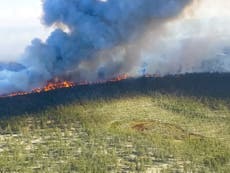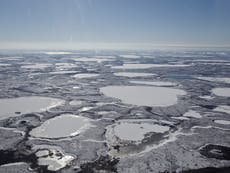Climate crisis: ‘Rising chance’ of temperatures exceeding 1.5C global target in near future
Met Office assessment for WMO reveals risk of breaching 1.5C mark has doubled since last major study

A boy cools off at a punctured water supply line on a road as a heatwave continues in Karachi, Pakistan ( EPA )
\
The planet is on course to break the 1.5C warming barrier in the next few years, according to the World Meteorological Organisation, only five years after the limit was agreed at the landmark 2015 Paris climate agreement.
The deal, to which almost every country in the world signed up, was to reduce greenhouse gas emissions sufficiently to keep global temperatures this century “well below” 2C of warming and to pursue efforts to limit the increase to 1.5C.
“In each of the coming five years (2020-2024) and there is a 20 per cent chance that it will exceed 1.5C in at least one year, according to new climate predictions,” the WMO has now said, adding that the 1.5C mark stood a 70 per cent chance of being exceeded during one or more months during the same time frame.
The last five-year period has been the warmest five years on record, and the global average temperature first surpassed 1C above what it was during the pre-industrial period in just 2015.
Temperatures around the world had been slowly falling for around 6,000 years before the impact of the industrial revolution reversed the trend in less than 150 years.
Read more

THE THING 1951
https://en.wikipedia.org/wiki/The_Thing_from_Another_World
UK won't meet climate targets and the risks are ‘bigger than covid’
The new climate assessment, carried out by the UK’s Met Office on behalf of the WMO, is based on the expertise of internationally acclaimed climate scientists as well as the world’s best computer models, and provides a climate outlook for the next five years, updated annually.
The last such assessment suggested the short-term chance of hitting 1.5C of warming stood at 10 per cent. The new study doubles the risk.
WMO Secretary-General Petteri Taalas said: “This study shows – with a high level of scientific skill – the enormous challenge ahead in meeting the Paris Agreement on Climate Change target of keeping a global temperature rise this century well below 2 degrees Celsius above pre-industrial levels and to pursue efforts to limit the temperature increase even further to 1.5 degrees Celsius.”
The predictions take into account natural variations in weather and climate as well as human influences on the planet and other variables for the coming five years.
But the forecast models do not take into consideration the reductions in emissions of greenhouse gases due to the coronavirus lockdown.
“[The] WMO has repeatedly stressed that the industrial and economic slowdown from Covid-19 is not a substitute for sustained and coordinated climate action. Due to the very long lifetime of CO2 in the atmosphere, the impact of the drop in emissions this year is not expected to lead to a reduction of CO2 atmospheric concentrations which are driving global temperature increases,” said Professor Taalas.
“Whilst Covid-19 has caused a severe international health and economic crisis, failure to tackle climate change may threaten human well-being, ecosystems and economies for centuries.
“Governments should use the opportunity to embrace climate action as part of recovery programmes and ensure that we grow back better,” he said.
Professor Adam Scaife, the head of long-range prediction at the Met Office Hadley Centre said: “This is an exciting new scientific capability. As human-induced climate change grows, it is becoming even more important for governments and decision makers to understand the current climate risks on an annually-updated basis.”
The new climate assessment, carried out by the UK’s Met Office on behalf of the WMO, is based on the expertise of internationally acclaimed climate scientists as well as the world’s best computer models, and provides a climate outlook for the next five years, updated annually.
The last such assessment suggested the short-term chance of hitting 1.5C of warming stood at 10 per cent. The new study doubles the risk.
WMO Secretary-General Petteri Taalas said: “This study shows – with a high level of scientific skill – the enormous challenge ahead in meeting the Paris Agreement on Climate Change target of keeping a global temperature rise this century well below 2 degrees Celsius above pre-industrial levels and to pursue efforts to limit the temperature increase even further to 1.5 degrees Celsius.”
The predictions take into account natural variations in weather and climate as well as human influences on the planet and other variables for the coming five years.
But the forecast models do not take into consideration the reductions in emissions of greenhouse gases due to the coronavirus lockdown.
“[The] WMO has repeatedly stressed that the industrial and economic slowdown from Covid-19 is not a substitute for sustained and coordinated climate action. Due to the very long lifetime of CO2 in the atmosphere, the impact of the drop in emissions this year is not expected to lead to a reduction of CO2 atmospheric concentrations which are driving global temperature increases,” said Professor Taalas.
“Whilst Covid-19 has caused a severe international health and economic crisis, failure to tackle climate change may threaten human well-being, ecosystems and economies for centuries.
“Governments should use the opportunity to embrace climate action as part of recovery programmes and ensure that we grow back better,” he said.
Professor Adam Scaife, the head of long-range prediction at the Met Office Hadley Centre said: “This is an exciting new scientific capability. As human-induced climate change grows, it is becoming even more important for governments and decision makers to understand the current climate risks on an annually-updated basis.”




No comments:
Post a Comment